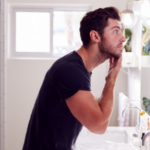Muscle dysmorphia is a form of body dysmorphic disorder (BDD) first described in a group of bodybuilders.
Like other people with body dysmorphic disorder, people with muscle dysmorphia perform repetitive behaviours because of concerns about their appearance, and they experience significant distress or impairment of day-to-day activities.
The distinguishing characteristic of the muscle dysmorphia specification of body dysmorphic disorder is that the person is concerned that their body is too small or not muscular enough (often, but not always, with accompanying concerns about other parts of their body).
Most people with muscle dysmorphia use diet, exercise and/or weightlifting, often excessively, to address their concerns, and therefore have normal or very muscular physiques2.
Muscle dysmorphia is more prevalent in males than females, with some studies suggesting the disorder occurs exclusively in men1, .
However, a recent study of Australian adolescents (representative of the population) indicates that muscle dysmorphia is present in 2.2% of males and 1.4% of females, with no ‘statistically significant’ gender difference in prevalence.
Australian adolescent males have a higher drive for muscularity than females, and those with muscle dysmorphia are more likely than their female counterparts to have a severe preoccupation with their perceived lack of muscularity and have weight training interfere with their daily life4.
Australian boys and young men experience less discomfort from others seeing their bodies than their female peers.
There are reasons to suspect that men and boys are unlikely to seek help for muscle dysmorphia, which is particularly worrying given that people with the disorder have high rates of substance use, suicidality and other psychiatric problems4.
Australian data show that Australian boys aged 14-15 years are less likely than girls to seek help for personal or emotional problems, but individuals with muscle dysmorphia may not have insight into their disorder.
Recognition of muscle dysmorphia in males can be difficult because characteristic behaviours (e.g. diet and exercise) may be mistaken as beneficial to the person’s health.
A series of questions to determine the presence of muscle dysmorphia in athletes has been proposed, relating to the social effects, time costs and behaviours associated with diet and exercise:
Effective management of body dysmorphic disorder, including muscle dysmorphia, requires psychotherapy, in some cases with pharmacological treatment.
This provides the best chance of avoiding the functional impairments and psychiatric comorbidities that characterise and accompany muscle dysmorphia.













